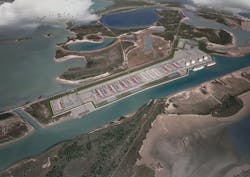NextDecade lets contract, snags investor for Rio Grande LNG project
Robert Brelsford
Downstream Technology Editor
Privately held NextDecade LLC, The Woodlands, Tex., has let a contract to General Electric International Inc.'s oil and gas division to serve as exclusive equipment supplier for liquefaction trains and associated pipelines to be built as part of subsidiary Rio Grande LNG LLC's proposed 27 million-tonne/year LNG export terminal in Brownsville, Tex. (OGJ Online, Sept. 9, 2016).
GE Oil & Gas will provide gas turbine and compressor equipment for LNG liquefaction trains at Rio Grande LNG's plant as well as for fellow NextDecade subsidiary Rio Bravo Pipeline Co.'s Rio Bravo pipeline, which will be developed in conjunction with the project, NextDecade said.
The proposed 27 million-tonne/year Rio Grande LNG liquefaction and export project will be supplied with gas from the Rio Bravo Pipeline. Artist rendering of facility citing in Brownsville, Tex., from NextDecade LLC.
In addition to supply of gas turbine and compressor equipment, GE's scope of work under the contract includes delivery of long-term services, life-cycle maintenance agreements, and performance guarantees.
Alongside its agreement to become exclusive supplier to the Rio Grande LNG and Rio Bravo Pipeline projects, GE Oil & Gas also has agreed to a common equity investment in NextDecade, which will grant the service company a right to invest up to a specified amount in project-level equity and debt financing for Rio Grande LNG at the time of final investment decision, NextDecade said.
The deal with GE follows NextDecade's entrance into a definitive $1-billion merger agreement on Apr. 18 with New York-based Harmony Merger Corp., which upon closing in late second-quarter, will result in NextDecade becoming a publicly listed company, NextDecade said.
Project overview
Rio Grande LNG's natural gas liquefaction and LNG export project is seeking US Federal Energy Regulatory Commission approval for six 4.5 million-tpy liquefaction trains equipped with Air Products & Chemicals Inc.'s propane-mixed refrigerant (C3MR) technology, according to Rio Grande LNG's web site.
Alongside installations for natural gas pretreatment, the terminal will house four full-containment LNG storage tanks, truck-loading facilities, and two marine loading berths for receiving and loading LNG vessels.
As currently planned, Rio Bravo Pipeline's system will include two parallel 42-in. OD, 137.5-mile feed gas pipelines sharing a right-of-way that will begin in Kleberg and Jim Wells counties in Texas and will terminate next to the proposed export terminal.
Alongside unidentified associated installations, at full buildout, the pipeline system will feature:
• Three 180,000-hp compressor stations.
• Six mainline valve sites with two valves per location (one for each pipeline).
• Four metering sites housing a total of six meter stations along the pipeline system's header system, which will extend for 2.4 miles.
Designed to enable interconnection with various unaffiliated intrastate and interstate natural gas pipelines at multiple receipt points and scheduled for commissioning in phases, the pipeline system will have a total throughput capacity of 4.5 bcfd at full buildout, Rio Bravo Pipeline said.
The system's first pipeline will feature a first 1.5-bcfd phase due for startup in fourth-quarter 2020 before ramping up to 2.25 bcfd by third-quarter 2021. Rio Bravo Pipeline said it expects the second pipeline's first 1.5-bcfd phase to enter service in fourth-quarter 2022 before reaching its full capacity of 2.25 bcfd by first-quarter 2024.
Already approved by the US Department of Energy to export 27 million tpy of LNG to free-trade agreement countries for a 30-year term subject to ongoing regulatory approvals, NextDecade, which, to date, has nonbinding agreements in place for LNG sales of 30 million tpy, most recently said it expects to receive FERC approval for Rio Grande LNG this year, with initial LNG exports shipping by yearend 2020.
